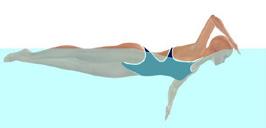
5 minute read
SWIMMING TECHNIQUE CONCEPTS: MAXIMIZING
BY ROD HAVRILUK , Ph.D.
MAXIMIZING SWIMMING VELOCITY (Part 3): MINIMIZING THE ARM ENTRY PHASE TIME IN FREESTYLE AND BUTTERFLY
Advertisement
The previous article (SW June 2021) in this series showed that with an increase in swimming velocity, there was a decrease in the time duration of all four phases of the stroke cycle for all four strokes. However, even at the fastest velocity, there was still a substantial amount of non-propulsive time in every stroke cycle, as shown in the data from four studies (Fig. 1): butterfly (Chollet, Seifert, Boulesteix, Carter, 2006), backstroke (Chollet, Seifert & Carter, 2008), breaststroke (Leblanc, Seifert, Baudry & Chollet, 2005) and freestyle (Seifert, Chollet & Bardy, 2004).
The non-propulsive time in a stroke cycle consists of the time for the entry phase and the recovery phase. This article presents strategies to minimize the entry phase time for freestyle and butterfly so that a swimmer can decrease stroke cycle time, increase stroke rate and increase swimming velocity.
FREESTYLE ENTRY PHASE
To swim fast, swimmers must minimize the entry phase time. However, even when sprinting, there is usually at least 2-tenths of a second of non-propulsive time before the arm begins to generate propulsion. The graph in Fig. 2 shows the consistency in the entry phase time for 10 groups of elite swimmers from eight studies (only the first author is listed: Chollet, 2000; Guignard, 2020; Millet, 2002; Potdevin, 2006; Seifert, 2003, 2004; Schnitzler, 2008, 2010).
The non-propulsive time on the arm entry is primarily due to the time required to move the arm from the position when it submerges to the position when it begins to generate propulsion. Research shows that when sprinting, male swimmers typically complete the arm entry parallel to the surface with the hand level with the shoulder, as shown by the male position in Fig. 3 (Havriluk, 2014). Female swimmers typically complete the entry with the hand above the shoulder, as shown by the female position.
With either a typical male or female arm entry, time is required for a swimmer to move the arm below the shoulder to a position where propulsion can begin (i.e., the optimal position). If, instead, the arm submerged below the shoulder to the optimal position as it entered, the entry phase time would be minimized.
FIG. 1 >The graph shows the time duration of propulsive and non-propulsive phases of the stroke cycle for all four strokes.
FIG. 2 > The graph shows the entry phase time for swimmers from eight studies. The letters above the bars indicate the sex of the study participants (M = males, F = females, MF = males and females).

BUTTERFLY ENTRY PHASE
Similar to freestyle, there is usually considerable excess time in the butterfly arm entry phase. For example, a typical butterfly arm entry for an elite swimmer is shown in the left image of Fig. 4. The swimmer’s hands are just below the surface, and her shoulders are submerged far below her hands. She required almost 2-tenths of a second of entry phase time to submerge her hands below her shoulders to a position where she could begin to generate propulsion, as shown in the right image.
The butterfly entry phase time was evaluated in a study of 23 university female swimmers (Becker & Havriluk, 2010). The group

FIG. 3 > The model shows the position of the arm at the completion of the typical male and female freestyle arm entries, as well as the optimal entry.
FIG. 4> An elite swimmer with a typical butterfly arm entry (left image). She required almost 2-tenths of a second to submerge her hands below her shoulders to a position where she could begin to generate propulsion (right image).
FIG. 5 > An effective arm entry for freestyle (left panel) and butterfly (right panel).


required an average of over 3-tenths of a second to submerge the hands below the shoulders to a position where they could begin to generate propulsion.
STRATEGIES TO MINIMIZE ENTRY PHASE TIME
Strategies to minimize entry phase time are similar for freestyle and butterfly. For both strokes, it is important to:
1. Position the elbow above the hand when the arm is above the surface and about to submerge (Fig. 5, top panel)
2. Angle the arm downward as the arm submerges (middle panel)
3. Complete the arm entry with the hand below the shoulder (bottom panel).






4. If the hand is below the shoulder when the arm straightens (Fig. 5, bottom panel), a swimmer can immediately begin to generate propulsion. An effective arm entry for freestyle or butterfly requires no more than 1-tenth of a second and would eliminate at least 50% of the typical non-propulsive entry phase time. v
Dr. Rod Havriluk is a sport scientist and consultant who specializes in swimming technique instruction and analysis. His newest ebooks in the “Approaching Perfect Swimming” series are “Optimal Stroke Technique” and “Swimming Without Pain,” and are available at swimmingtechnology.com. Contact Rod through info@swimmingtechnology.com. All scientific documentation relating to this article, including scientific principles, studies and research papers, can be provided upon demand.
SUMMARY
An effective arm entry in either freestyle or butterfly can substantially decrease the time of the entry phase. A reduction in nonpropulsive, entry phase time decreases the stroke cycle time, increases the stroke rate and increases swimming velocity.
TOTAL ACCESS MEMBERS CLICK HERE TO LEARN MORE ABOUT THE REFERENCES FOR THIS ARTICLE. NOT A TOTAL ACCESS MEMBER? YOU’RE JUST A CLICK AWAY: SWIMMINGWORLD.COM/VAULT










